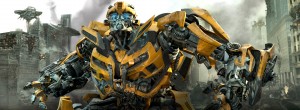Dark of the Moon transforms a successful franchise
Transformers: Dark of the Moon opens with a space battle worthy of Star Wars that introduces legendary Autobot warrior Sentinel Prime (Leonard Nimoy), who crashlands on the Earth’s moon in the midst of the 1960s space race between America and Russia, before promptly jumping to the present to find the Autobots working with mankind to eliminate terrorists and what few Decepticons remain.
Where a film could go from there is a question only blockbuster producer Michael Bay could answer.

New model · Carly (Rosie Huntington-Whiteley) hangs on Sam’s (Shia LaBeouf) illustrious arm as Mikaela (Megan Fox) is glossed over. - Photo courtesy of Paramount Pictures
Meanwhile, Sam Witwicky (Shia LaBeouf) is leading a dull, unemployed existence in Washington, D.C. His hot new girlfriend Carly (Rosie Huntington-Whiteley) is a consolation, sure, but now that he can no longer hang out with Optimus (Peter Cullen), Bumblebee and the other Autobots, he feels like he doesn’t have a purpose in life.
Needless to say, Sam and the Autobots eventually come together to unravel the secret of the dark side of the moon. Massive battles and destruction on an epic scale ensues, as the fate of Earth hangs in the balance.
Transformers: Dark of the Moon had a lot riding on its shoulders. After a promising start in 2007 and an awful sequel in 2009, the franchise needed to compel audiences to take it seriously. Fortunately, its third entry is not just easily its best but also hands down the best live-action 3D film after Avatar.
Bay has always been a master of action filmmaking, but his propensity for rapid-fire editing rendered the action sequences of the first two films virtually incomprehensible and unwatchable. Now, however, all the battles consist of much longer shots, a consequence of the new 3D cameras forcing Bay to have less cuts. The results are mind-blowing — every action scene is fluid, energetic and easy on the eyes.
Whether it’s the sight of Optimus Prime battling a giant worm-like Decepticon or a bunch of American soldiers flying in formation as huge warships fire around them, the visual effects are spectacular and every single element is there in vivid detail. The film has also thankfully jettisoned much (though not all) of the low-brow sitcom aspects that consistently irritated during the previous installments. The gruesome twosome of Mudflap and Skids is completely nonexistent here and Sam’s obnoxious parents barely arrive for a cameo. Admittedly, Sam’s cartoonish co-worker later almost manages to fulfill their camp humor contribution. Once he’s gone, the picture settles on a notably darker and more serious tone, with some characters actually dying. Bay doesn’t pull punches as much as he used to.
It also helps the film still has a pretty good cast. LaBeouf is still the grounding force in this movie and he sells even the weakest dialogue, while series newcomers Frances McDormand and John Malkovich as an uptight NSA Agent and Sam’s over-the-top and hilarious new boss both manage to charm in their limited screen time. Whiteley is a fine substitute for the conspicuously absent Megan Fox, whose Mikaela apparently dumped Sam between films for reasons the film never delves into.
The picture still has all the flaws that plagued its predecessors — one-dimensional, unsubtle characterization, an overabundance of unnecessary subplots that bog down pacing and gaping plot holes.
Yet Dark of the Moon renders all these shortcomings negligible with its sheer technical professionalism. The film’s third act, in which the Decepticons ravage Chicago, is one of the longest, most relentless, tense and exciting set-pieces to ever make it to celluloid. It is pure visual spectacle on a grandiose scale that is worth the price of admission alone.
One critic at the film’s world premiere at the Moscow International Film Festival compared watching it to getting a massage.
It’s hard to disagree.

